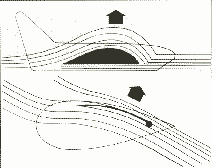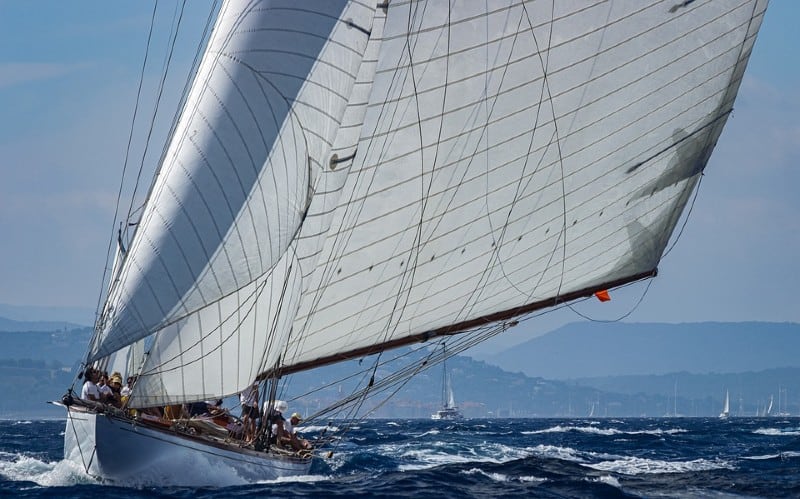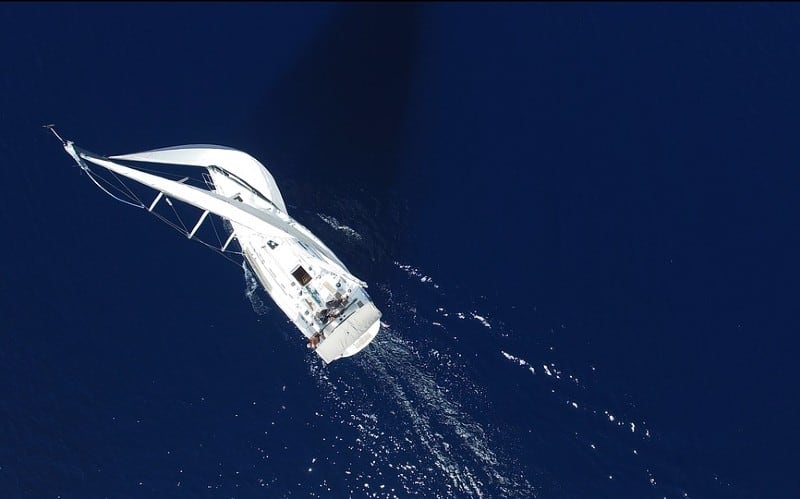How Do Sailboats Work?
To a casual observer, a sailboat makes perfect sense. Wind pushes the boat forward on the water. The boat goes in the direction of the wind. The true physics of sailing a boat are definitely more complicated. How do you sail against the wind? Why does the sailboat move forward if wind hits the sails from the side? How do you sail perpendicular to the wind? How does a sailboat move faster than the wind?
There’s a lot to understand about how sailboats work. Much of it is not obvious at first. You need to understand your boat design and drag force. Also point of sail and beam reach. The direction of the wind is just one piece of the puzzle. Once you understand it all, sailing becomes much easier.
Let’s take a look at the physics of sails and wind, and how they work together. Understanding these forces is key for any sailor who wants to master sailing. At least in the true “wind in your sails” sense of the word.
How Does a Sailboat Sail?
The physics of how a sailboat sails does depend on wind direction. Sailing your boat downwind with the wind at your back is easy to understand. Wind fills the sails and pushes the boat forward on the water. At angles, it takes more of an understanding of physics to explain.
Sails on a boat work like the wings of an airplane. Both create aerodynamic lift to move an object. In the case of a boat, even when wind comes from the side, it moves the boat forward.
If you viewed a sailboat from above, it would resemble the wing of an airplane. The difference would just be that it seems to be on its end.
Air hits your sails and makes lift. Some of the force is lost thanks to friction. Some of that force pushes your boat forward. The rest would push the sailboat sideways if it could. But it can’t, and this is where the aerodynamics of your sail meet the hydrodynamics of the keel.
Because the boat has a keel or centerboard, it can move forward. This part of your sailboat extends under the water. It balances the boat and keeps it running straight. Without a keel, your sailboat would drift wherever the wind pushes it. However, the keel acts with the sails to make forward motion. There will be a small amount of sideways motion as well. This is how your sailboat is able to sail.
As your hull and keel resist sideways motion, that force is translated into motion. When you are sailing upwind, the wind needs to travel smoothly front the front of the sail to the back. If it doesn’t, you won’t be moving far. This can be hard for new sailors to master.
The Orange Seed Test
A fun example of how to understand the forward motion is to get a seed from an orange. These are roughly the same shape as a boat’s keel. Put the seed on a smooth table and then squish it with your thumb. The seed will squirt out from under your thumb in a forward direction. The same basic principle applies to your sailboat. Force applied to it redirects as forward motion.
What Does Point of Sail Mean On a Sailboat?
The sails on your sailboat can be rigged at different angles. This is essential for catching and making use of wind. These angles are called point of sail. You need to alter the angle as you sail when the wind changes. Otherwise you will lose that forward motion that you want.
Adjusting the sails is called trimming them. You do this by adjusting the tension of the line, called a sheet, attached to the sail. When you pull the sheet in, it moves the sail towards the center of the boat. When you let the tension out, or sheet it, it lets the sail out.
It can be hard to master trimming the sails. The wind is rarely cooperative. It may come in at constantly changing angles. You will need to adjust accordingly. This is a learning process, and no one is an expert sailor their first time out.
Trimming Sails Upwind
It can be hard to trim the sails when you are sailing upwind. The angle of the sail needs to be just right to allow proper airflow. If you have sheeted too far out or in, it will not work. You will not get that wing shape you want, and you will stall out in the water.
The easiest way to trim your sails upwind is by trial and error. Sheet your sails out until they flap loosely. This flapping is called luff. Then sheet the sail back in slowly. Watch the shape and tension of the sail. When it smooths out and curves there is no more luff. This is where you want it to be.
How to Turn Upwind
Turning upwind is called heading up. Sometimes it is called bearing up or pointing up. If you push the tiller towards the sail and away from yourself, you are turning upwind. The sails need to be trimmed along with the turning. The angle of the wind is going to change. If the sails are not sheeted, you will lose the wind.
Trimming Sails Perpendicular to the Wind
Treat winds perpendicular the same as upwind. The process of trimming the sails will be the same. Smooth out the luff and proceed on course once you have that wing shape.
Trimming Sails Downwind
Despite what you may think, trimming sails downwind can be hard. The sails will naturally parachute or balloon in the wind. To control them takes work. You need to try to get the sail perpendicular to the wind. This will expose the maximum surface of the sail. Thus, you get the most lift. Again, this is a trial and error process to get it right.
How to Turn Downwind
Turning downwind is also called falling off. This is also called bearing away or pointing down. You do this by turning the tiller towards yourself and away from the sail. Like turning upwind, the sail needs to be adjusted. You will have to sheet out to maintain your course.
What is Tacking?
When you want to sail into the wind, you need to engage in what is called tacking. A sailboat cannot head directly into the wind on a straight course. This puts you in the No Go Zone. The angles we mentioned earlier, or points of sail, can be divided on different tacks. There are port tacks and starboard tacks. They divide around the boat very similar to how a clock looks. Tack, then, has two different meanings. An angle relates to the wind and also the directional corrections you make into the wind.
You need to be about 45 degrees off the wind in any direction to keep sailing. In the No Go Zone, your boat is dead in the water. You will need to engage in a maneuver calling tacking to get out of it. This involves sailing in a zig zag pattern. The direction of the wind will shift from one side of the boat to the other. This allows you to keep moving towards the wind. It will keep you on course, it just may take more time.
How Do You Tack?
Learning how to tack is a process. It’s not always simple. Try the following steps to tack into the wind.
- Turn towards the wind by pushing the tiller towards the sail. Do this in a slow and controlled manner.
- As the boat turns, step across the board without letting go of the tiller or the main sheet.
- The sail will tack when it switches sides. When this happens, sit down on the new side of the boat, opposite the sail.
- Center the boat again so that you’re on a straight course.
- You’ll need to switch hands here. But don’t let go of the mainsheet or the tiller. Run the hand holding the sheet along the mainsheet until you have the tiller. Then let go of the tiller with your other hand.
- Now you can grab the sheet with your free hand, having successfully switched.
- Trim your sail as necessary. You have just tacked in one direction. If you need to keep heading into the wind, you will need to tack back by repeating the process in reverse. This can continue as long as necessary to get you where you want to go. The end result is a zig zag through the water.
How Do You Control Speed in a Sailboat?
When the wind really picks up, a sailboat can move extremely fast. Sailboats can go from 4 miles per hour to nearly 20 miles per hour. So how do you stop that when you need to?
If your boat is travelling upwind and needs to stop, sheet your sails. Let them luff briefly, which will disrupt the speed of your boat. You can sheet back in again when you are ready.
Downwind is harder. There is little resistance from the water on your boat in this direction. You can sheet your sails in to slow the boat down somewhat. However, your momentum will still carry you for some time.
You can point the bow of a boat upwind to stop. Alternately, you can point the boat perpendicular to the wind and luff the sails. Downwind, however, you have no options to stop a boat.
How Do Some Boats Sail Faster Than the Wind?
This has to do with a phenomenon called apparent wind. Apparent wind is the wind you feel on your face as you move forward. True wind is the wind that is blowing naturally.
If you can imagine riding your bicycle on a day when there is no wind whatsoever, you still feel wind on your face (apparent wind) and it gets stronger as you go faster. That is because your forward motion is creating its own wind. If you were to ride your bike on a day when there was a 5 mile per hour wind behind you and you were pedaling at 5 miles per hour, the two winds (true and apparent) would cancel each other and you would not feel any wind at all.
Boats that are able to sail faster than the true wind are “creating their own wind”. Generally these are fast catamarans and iceboats, although some racing monohulls may be able to achieve this. The apparent wind is the wind that the boat sails in. Usually, you can sail faster at 70 degrees to 80 degrees off the apparent wind (called a “close reach”) than you can with the wind directly behind you.
This is because you can trim the sails so that the wind flows over them to create a lift, much like an airplane wing, that propels the boat. As you can see, there is a positive force against the inside of the sail, and a negative force pulling the outside of the sail. (You can try this by holding your hand out of the window of a moving car (With your parent’s permission, please!). Rotate your hand to feel how the wind pushes and pulls on it at different angles.)
Under optimum conditions, the apparent wind is greater than the true wind. Let’s say you are on a fast catamaran and sailing in a true wind of 10 knots. By moving very fast through the water you may be able to create an apparent wind of 20 knots which may allow you to sail at 12 to 13 knots, which is faster than the true wind. (Friction will keep you from moving as fast as the apparent wind.)
Categories: Boats


















